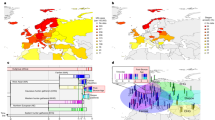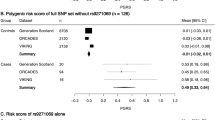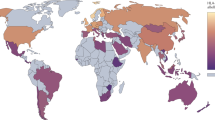Abstract
There is strong evidence for both genetic and environmental risk factors comprising the aetiology of multiple sclerosis (MS). While much progress has been made in recent years in identifying common genetic variants using genome-wide association studies, alternative approaches have remained relatively neglected. The prevalence of MS in Orkney and Shetland is among the highest in the world. Previous studies have suggested that a higher degree of parental relatedness in these isolated communities may contribute to the high rates of MS, indicating that recessive effects have an important role in MS aetiology. The Northern Isles Multiple Sclerosis (NIMS) study investigated the potential role of genome-wide homozygosity in MS risk by genotyping 88 MS patients, 89 controls matched by age, sex and ancestry, and a further 89 controls matched for sex and ancestry, but passed the majority of lifetime risk of developing MS (>70 years of age). Three participants were removed on the basis of pedigree-genomic anomalies (n=263). Three measures of genome-wide homozygosity were generated for each individual, and association with MS was assessed using logistic regression models. No effect of genome-wide homozygosity was detected, indicating that inbreeding and consanguinity are not risk factors for MS in this population.
Similar content being viewed by others
Log in or create a free account to read this content
Gain free access to this article, as well as selected content from this journal and more on nature.com
or
References
Sawcer S, Ban M, Maranian M et al: A high-density screen for linkage in multiple sclerosis. Am J Hum Genet 2005; 77: 454–467.
Olerup O, Hillert J : HLA class II-associated genetic susceptibility in multiple sclerosis: a critical evaluation. Tissue Antigens 1991; 38: 1–15.
Naito S, Namerow N, Mickey MR, Terasaki PI : Multiple sclerosis: association with HL-A3. Tissue Antigens 1972; 2: 1–4.
Oksenberg JR, Baranzini SE, Sawcer S, Hauser SL : The genetics of multiple sclerosis: SNPs to pathways to pathogenesis. Nat Rev Genet 2008; 9: 516–526.
Oksenberg JR, Barcellos LF, Cree BAC et al: Mapping multiple sclerosis susceptibility to the HLA-DR locus in African-Americans. Am J Hum Genet 2004; 74: 160–167.
Reich D, Patterson N, De Jager PL et al: A whole-genome admixture scan finds a candidate locus for multiple sclerosis susceptibility. Nat Genet 2005; 37: 1113.
Chao MJ, Barnardo MCNM, Lincoln MR et al: HLA class I alleles tag HLA-DRB1*1501 haplotypes for differential risk in multiple sclerosis susceptibility. Proc Natl Acad Sci USA 2008; 105: 13069–13074.
Rosati G : The prevalence of multiple sclerosis in the world: an update. Neurol Sci 2001; 22: 117–139.
Roberts DF : Consanguinity and multiple sclerosis in Orkney. Genet Epidemiol 1991; 8: 147–151.
Roberts DF, Papiha SS, Poskanzer DC : Polymorphisms and multiple sclerosis in Orkney. J Epidemiol Commun H 1979; 33: 236–242.
Roberts DF, Roberts MJ, Poskanzer DC : Genetic analysis of multiple sclerosis in Shetland. J Epidemiol Commun H 1983; 37: 281–285.
Roberts DF, Roberts MJ, Poskanzer DC : Genetic analysis of multiple sclerosis in Orkney. Br Med J 1979; 33: 229–235.
Dean G, Goodall J, Downie A : The prevalence of multiple sclerosis in the Outer Hebrides compared with north-east Scotland and the Orkney and Shetland Islands. J Epidemiol Commun H 1981; 35: 110–113.
Poskanzer D, Terasaki PI, Prenney LB, Sheridan JL, Park MS : Multiple sclerosis in the Orkney and Shetland Islands III: histocompatibility determinants. J Epidemiol Commun H 1980; 34: 253–257.
Poskanzer DC, Prenney LB, Sheridan JL, Kondy JY : Multiple sclerosis in the Orkney and Shetland Islands. I: epidemiology, clinical factors, and methodology. J Epidemiol Commun H 1980; 34: 229–239.
Poskanzer DC, Sever JL, Sheridan JL, Prenney LB : Multiple sclerosis in the Orkney and Shetland Islands. IV: viral antibody titres and viral infections. J Epidemiol Commun H 1980; 34: 258–264.
Poskanzer DC, Sever JL, Terasaki PI, Prenney LB, Sheridan JL, Park MS : Multiple sclerosis in the Orkney and Shetland Islands. V: the effect on viral titres of histocompatibility determinants. J Epidemiol Commun H 1980; 34: 265–270.
Poskanzer DC, Sheridan JL, Prenney LB, Walker AM : Multiple sclerosis in the Orkney and Shetland Islands. II: the search for an exogenous aetiology. J Epidemiol Commun H 1980; 34: 240–252.
Poskanzer DC, Walker AM, Yonkondy J, Sheridan JL : Studies in the epidemiology of multiple sclerosis in the Orkney and Shetland Islands. Neurology 1976; 26: 14–17.
Taylor R, Illsley R, Poskanzer DC : Multiple sclerosis in the Orkney and Shetland Islands. VI: the effects of migration and social structure. J Epidemiol Commun H 1980; 34: 271–276.
Hoppenbrouwers IA, Pardo Cortes LM, Aulchenko YS et al: Familial clustering of multiple sclerosis in a Dutch genetic isolate. Mult Scler 2007; 13: 17–24.
Sadovnick AD, Yee IML, Ebers GC : Recurrence risks to sibs of MS index cases: impact of consanguineous matings. Neurology 2001; 56: 784–785.
Tienari PJ, Sumelahti M-L, Rantamäki T, Wikström J : Multiple sclerosis in western Finland: evidence for a founder effect. Clin Neurol Neurosurg 2004; 106: 175–179.
Callander M, Landtblom A-M : A cluster of multiple sclerosis in Lysvik in the Swedish county of Värmland. Acta Neurol Scand 2004; 110: 14–22.
Botstein D, Risch N : Discovering genotypes underlying human phenotypes: past successes for mendelian disease, future approaches for complex disease. Nat Genet 2003; 33: 228–237.
Van Duijn CM, Dekker MCJ, Bonifati V et al: PARK7, a novel locus for autosomal recessive early-onset parkinsonism, on chromosome 1p36. Am J Hum Genet 2001; 69: 629–634.
Ewald H, Wikman FP, Teruel BM et al: A genome-wide search for risk genes using homozygosity mapping and microarrays with 1,494 single-nucleotide polymorphisms in 22 eastern Cuban families with bipolar disorder. Am J Med Genet B 2004; 133: 25–30.
McQuillan R : Homozygosity, Inbreeding and Health in European Populations, PhD thesis, University of Edinburgh, Edinburgh, UK, 2009.
McQuillan R, Leutenegger AL, Abdel-Rahman R et al: Runs of homozygosity in European populations. Am J Hum Genet 2008; 83: 359–372.
Kurtzke JF : Rating neurologic impairment in multiple sclerosis; an expanded disability status scale (EDSS). Neurology 1983; 33: 1445–1452.
Poser CM, Paty DW, Scheinberg L et al: New diagnostic criteria for multiple sclerosis: guidelines for research protocols. Ann Neurol 1983; 13: 227–231.
McDonald WI, Compston A, Edan G et al: Recommended diagnostic criteria for multiple sclerosis: guidelines from the International Panel on the diagnosis of multiple sclerosis. Ann Neurol 2001; 50: 121–127.
Polman CH, Reingold SC, Edan G et al: Diagnostic criteria for multiple sclerosis: 2005 revisions to the ‘McDonald Criteria’. Ann Neurol 2005; 58: 840–846.
Purcell S, Neale B, Todd-Brown K et al: PLINK: a toolset for whole-genome association and population-based linkage analysis. Am J Hum Genet 2007; 81: 559–575.
R Development Core Team: R: A language and environment for statistical computing. R Foundation for Statistical Computing, Vienna, Austria, 2008. http://www.R-project.org.
Roberts DF : Report on the Genetic Analysis of Multiple Sclerosis in the Orkney and Shetland Islands. National Institutes of Health, 1979.
Hildebrandt F, Heeringa SF, Rüschendorf F et al: A systematic approach to mapping recessive disease genes in individuals from outbred populations. PLoS Genet 2009; 5: e1000353.
Acknowledgements
We would like to thank the people of Orkney and Shetland who kindly participated in this study. We are also grateful to Dr Sarah Taylor, Dr Marthinus Roos and the general practices of Orkney and Shetland, for assistance in recruiting participants; Kay Lindsay and Susan Hermiston, for project management and administration; Jo Graham, for meticulous work in tracing the pedigrees of study participants; Mirna Kirin, for invaluable statistical advice; Gisela Barr, for data entry, and Lesley McGoohan, for database work. DNA extraction was performed at the Wellcome Trust Clinical Research Facility at the Western General Hospital, Edinburgh, and genotyping was performed at GeneProbe (Tepnel), Livingston, West Lothian. This work was supported by the MS Society UK, the Volant Trust and Royal Society.
Author information
Authors and Affiliations
Corresponding author
Ethics declarations
Competing interests
The authors declare no conflict of interest.
Rights and permissions
About this article
Cite this article
McWhirter, R., McQuillan, R., Visser, E. et al. Genome-wide homozygosity and multiple sclerosis in Orkney and Shetland Islanders. Eur J Hum Genet 20, 198–202 (2012). https://doi.org/10.1038/ejhg.2011.170
Received:
Revised:
Accepted:
Published:
Issue date:
DOI: https://doi.org/10.1038/ejhg.2011.170
Keywords
This article is cited by
-
The Newfoundland and Labrador mosaic founder population descends from an Irish and British diaspora from 300 years ago
Communications Biology (2023)
-
Contribution of common risk variants to multiple sclerosis in Orkney and Shetland
European Journal of Human Genetics (2021)
-
Patterns of homozygosity in insular and continental goat breeds
Genetics Selection Evolution (2018)
-
Runs of homozygosity: windows into population history and trait architecture
Nature Reviews Genetics (2018)



